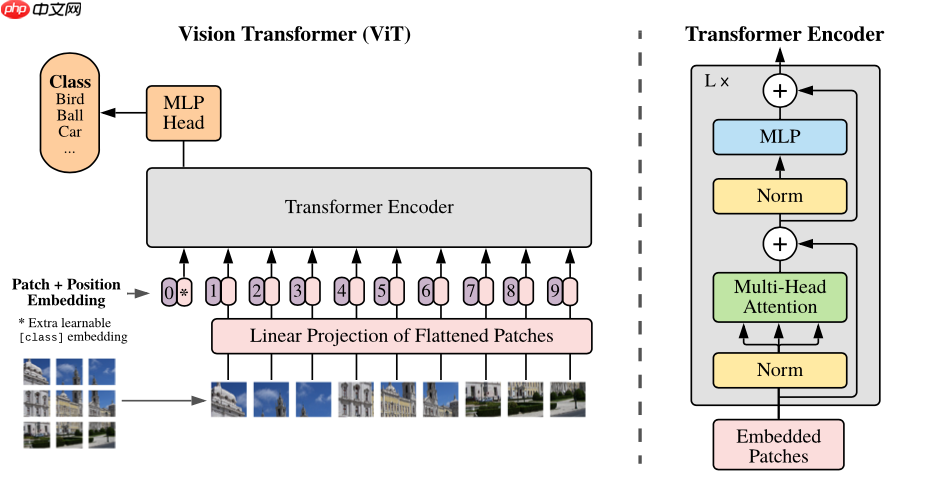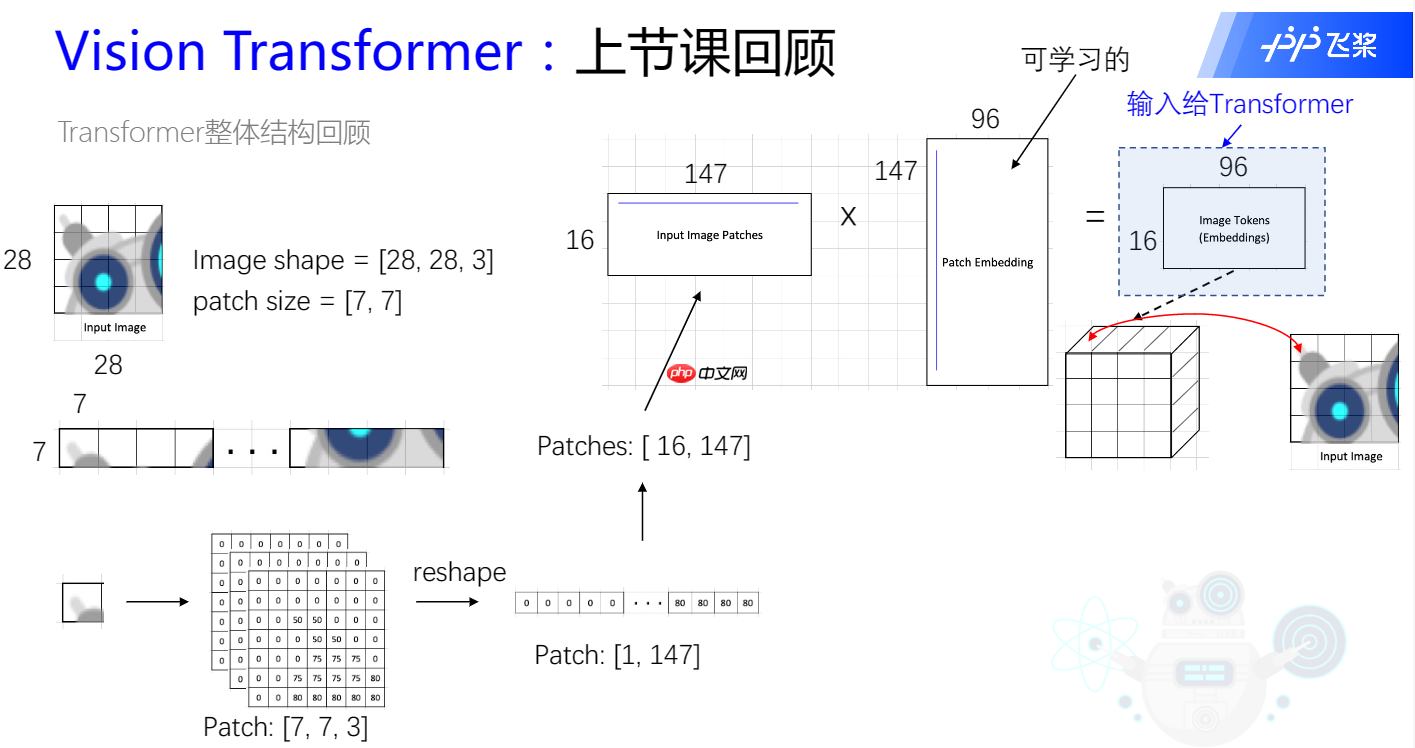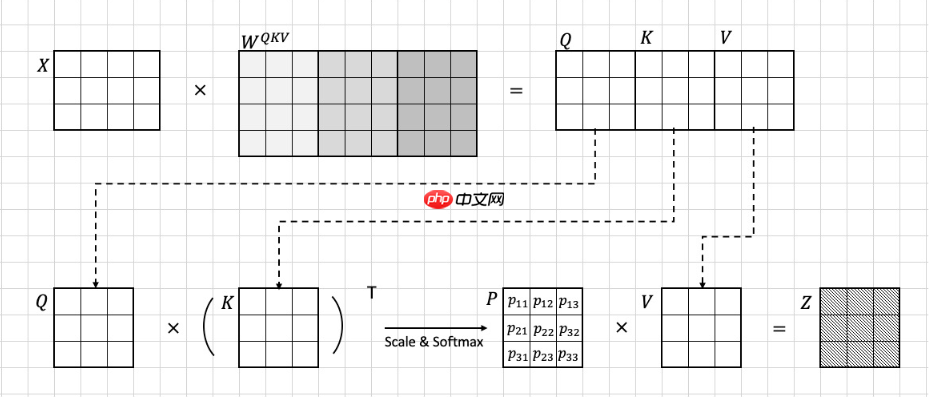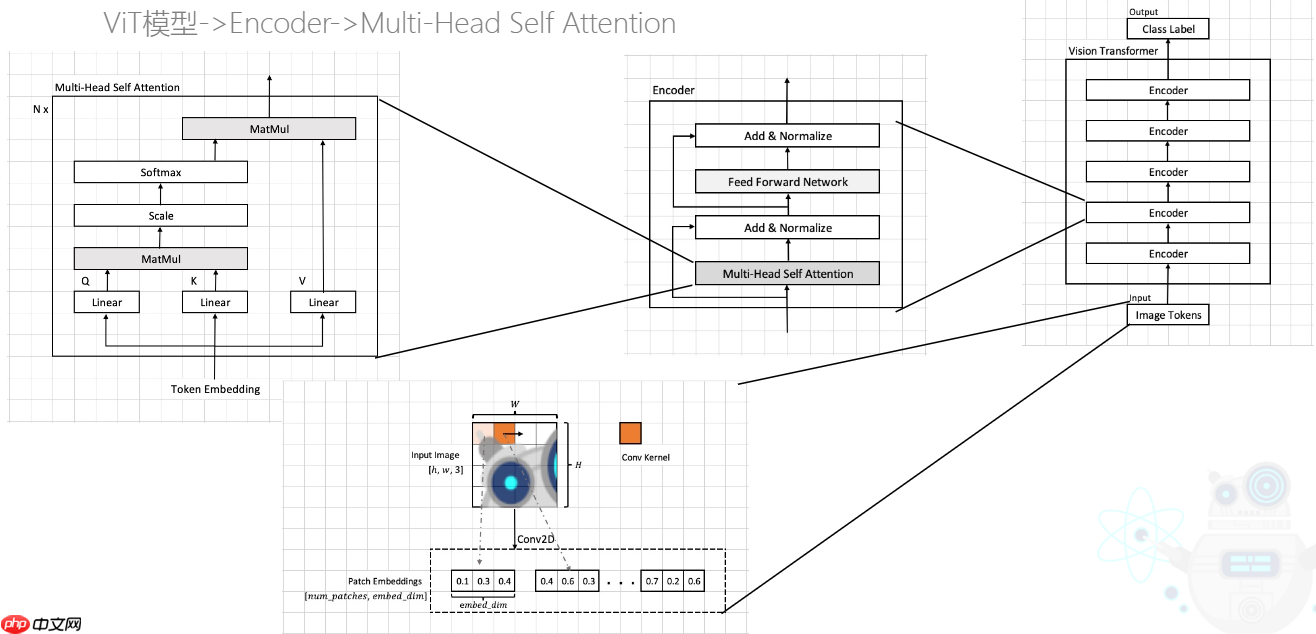本文介绍Vision Transformer,其不依赖CNN,适用于图像分类与迁移学习。含PatchEmbedding层(图片分块嵌入,加位置和分类token)、多头自注意力层、Encoder层(组合注意力与MLP等),整体结构在大型数据集上表现超SOTA模型。
☞☞☞AI 智能聊天, 问答助手, AI 智能搜索, 免费无限量使用 DeepSeek R1 模型☜☜☜

当前Transformer模型被大量应用在NLP自然语言处理当中,而在计算机视觉领域,Transformer的注意力机制attention也被广泛应用,比如Se模块,CBAM模块等等注意力模块,这些注意力模块能够帮助提升网络性能。而我们的工作展示了不需要依赖CNN的结构,也可以在图像分类任务上达到很好的效果,并且也十分适合用于迁移学习。Vision Transformer将CV和NLP领域知识结合起来,对原始图片进行分块,展平成序列,输入进原始Transformer模型的编码器Encoder部分,最后接入一个全连接层对图片进行分类。在大型数据集上表现超过了当前SOTA模型

PatchEmbedding主要是将输入的图片进行"分词",将图片转换成一个一个的小块传入,在NLP里就对应sequence,具体来说,例如下图所示,我们传进去的是(3,28,28)的图片,经过Embedding层之后就会变成16个7∗7 的小块,之后通过flatten将(7,7,3)打平成147个像素点,于是就变成(16,147),16就是我们所说的numpatchs,147再接上全连接层后对应的就是embeddim,在传进transforms之前需要将每一个token附上每一块的位置信息和分类模块,这里叫positionembedding和classtoken,二者值的确定都是可学习的参数,需要经过神经网络的学习进行优化


import paddleimport paddle.nn as nnclass PatchEmbedding(nn.Layer):
def __init__(self, image_size=224, patch_size=16, in_channels=3, embed_dim=768, dropout=0.):
super().__init__()
n_patches = (image_size // patch_size) * (image_size // patch_size)
self.patch_embedding = nn.Conv2D(in_channels=in_channels,
out_channels=embed_dim,
kernel_size=patch_size,
stride=patch_size)
self.dropout = nn.Dropout(dropout)
self.class_token = paddle.create_parameter(
shape=[1, 1, embed_dim],
dtype='float32',
default_initializer=nn.initializer.Constant(0.))
self.position_embedding = paddle.create_parameter(
shape=[1, n_patches+1, embed_dim],
dtype='float32',
default_initializer=nn.initializer.TruncatedNormal(std=.02)) def forward(self, x):
# [n, c, h, w]
clss_tokens = self.class_token.expand([x.shape[0], -1, -1]) # for batch,直接在第一个class_token后添加第一个X,之后将其拼接到X后
x = self.patch_embedding(x) # [n, embed_dim, h', w']
x = x.flatten(2)
x = x.transpose([0, 2, 1])
x = paddle.concat([clss_tokens, x], axis=1) return xtransform里面最重要的部分可以说就是attention层,attention层的思路也是起源于NLP,为了找到每一个patch与它附近的小块的信息,attention的目的就是使每一个token注意到其他部分的信息,也叫自注意力机制。具体地,如下图所示,X是Embedding的输出,可以看到他的patch数量是3,也就是说有3个token,这里看到图中的WqWkWv和P都是可学习的参数,其中我们将QKV合成一个大的矩阵,目的是后续直接将该矩阵切成三份,QK的作用就是和其他的token做运算之后经过scaleforsoftmax,收集它们的信息,之后在和V增加网络的复杂度

class Attention(nn.Layer):
"""multi-head self attention"""
def __init__(self, embed_dim, num_heads, qkv_bias=True, dropout=0., attention_dropout=0.):
super().__init__()
self.num_heads = num_heads
self.head_dim = int(embed_dim / num_heads)
self.all_head_dim = self.head_dim * num_heads
self.scales = self.head_dim ** -0.5
self.qkv = nn.Linear(embed_dim,
self.all_head_dim * 3)
self.proj = nn.Linear(embed_dim, embed_dim)
self.dropout = nn.Dropout(dropout)
self.attention_dropout = nn.Dropout(attention_dropout)
self.softmax = nn.Softmax(axis=-1) def transpose_multihead(self, x):
# x: [N, num_patches, all_head_dim] -> [N, n_heads, num_patches, head_dim]
new_shape = x.shape[:-1] + [self.num_heads, self.head_dim]
x = x.reshape(new_shape)
x = x.transpose([0, 2, 1, 3]) return x def forward(self, x):
B, N, _ = x.shape # x -> [N, num_patches, dim]
# x -> q, k, v
qkv = self.qkv(x).chunk(3, axis=-1) # 切分qkv
q, k, v = map(self.transpose_multihead, qkv)
attn = paddle.matmul(q, k, transpose_y=True) # q * k'
attn = attn * self.scales
attn = self.softmax(attn)
attn = self.attention_dropout(attn)
out = paddle.matmul(attn, v)
out = out.transpose([0, 2, 1, 3])
out = out.reshape([B, N, -1])
out = self.proj(out)
return out可以看到,在实现最重要的attention之后,还需要实现MLP,layearnormalize以及残差层链接,组成Encoder层,五个Encoder组成一个transform,在每个Encoder以及每个MLP,layearnormalize都不会改变数据的维度,目的是我们增加层数时不会变更太多

class Identity(nn.Layer):
def __init__(self):
super().__init__() def forward(self, x):
return xclass Mlp(nn.Layer):
def __init__(self, embed_dim, mlp_ratio, dropout=0.):
super().__init__()
self.fc1 = nn.Linear(embed_dim, int(embed_dim * mlp_ratio))
self.fc2 = nn.Linear(int(embed_dim * mlp_ratio), embed_dim)
self.act = nn.GELU()
self.dropout = nn.Dropout(dropout) def forward(self, x):
x = self.fc1(x)
x = self.act(x)
x = self.dropout(x)
x = self.fc2(x)
x = self.dropout(x) return xclass EncoderLayer(nn.Layer):
def __init__(self, embed_dim=768, num_heads=4, qkv_bias=True, mlp_ratio=4.0, dropout=0., attention_dropout=0.):
super().__init__()
self.attn_norm = nn.LayerNorm(embed_dim)
self.attn = Attention(embed_dim, num_heads)
self.mlp_norm = nn.LayerNorm(embed_dim)
self.mlp = Mlp(embed_dim, mlp_ratio) def forward(self, x):
# TODO
h = x # residual
x = self.attn_norm(x)
x = self.attn(x)
x = x + h
h = x
x = self.mlp_norm(x)
x = self.mlp(x)
x = x + h return x
class Encoder(nn.Layer):
def __init__(self, embed_dim, depth):
super().__init__()
layer_list = [] for i in range(depth):
encoder_layer = EncoderLayer()
layer_list.append(encoder_layer)
self.layers = nn.LayerList(layer_list)
self.norm = nn.LayerNorm(embed_dim) def forward(self, x):
for layer in self.layers:
x = layer(x)
x = self.norm(x) return x
class VisualTransformer(nn.Layer):
def __init__(self,
image_size=224,
patch_size=16,
in_channels=3,
num_classes=1000,
embed_dim=768,
depth=3,
num_heads=8,
mlp_ratio=4,
qkv_bias=True,
dropout=0.,
attention_dropout=0.,
droppath=0.):
super().__init__()
self.patch_embedding = PatchEmbedding(image_size, patch_size, in_channels, embed_dim)
self.encoder = Encoder(embed_dim, depth)
self.classifier = nn.Linear(embed_dim, num_classes) def forward(self, x):
# x:[N, C, H, W]
x = self.patch_embedding(x) # [N, embed_dim, h', w']
# x = x.flatten(2) # [N, embed_dim, h'*w'] h'*w'=num_patches
# x = x.transpose([0, 2, 1]) # [N, num_patches, embed_dim]
print(x.shape)
x = self.encoder(x) print(x.shape)
x = self.classifier(x[:, 0]) return xdef main():
t = paddle.randn([4, 3, 224, 224])
vit = VisualTransformer()
out=vit(t) print('aaaaaaaaaa',out.shape)
paddle.summary(vit, (4, 3, 224, 224)) #查看网络详细信息if __name__ == "__main__":
main()以上就是复现篇:Vision Transform复现及讲解的详细内容,更多请关注php中文网其它相关文章!

每个人都需要一台速度更快、更稳定的 PC。随着时间的推移,垃圾文件、旧注册表数据和不必要的后台进程会占用资源并降低性能。幸运的是,许多工具可以让 Windows 保持平稳运行。

Copyright 2014-2025 https://www.php.cn/ All Rights Reserved | php.cn | 湘ICP备2023035733号